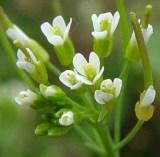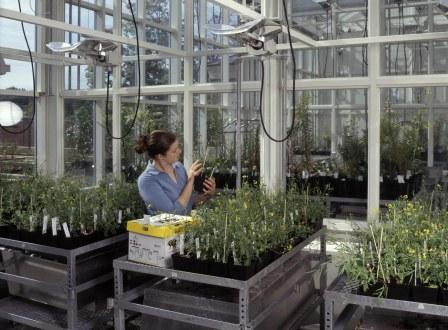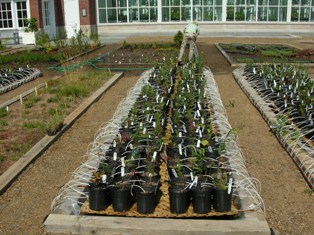Current Research
Research in our laboratory is currently focused in two areas: 1) the physiological basis for inter- and intra-specific variation in response to elevated atmospheric carbon dioxide levels, and 2) delineating the physiological and ecological tolerance limits of the rare elements of the Atlantic Coastal Plain flora in Nova Scotia.
 |
h | The first project attempts to explain the often diverse effects of elevated carbon dioxide on plant growth and development. We use a range of different species as model systems including Arabidopsis because of the wealth of information that has accumulated on its developmental pathways. This work contributes to our understanding of how natural populations will evolve, as well as what traits we should select for in managed populations in a future high carbon dioxide world. |
The Atlantic Coastal Plain flora contains many of Nova Scotia’s rare and endangered species. The rarest of these species are limited to a small number of low nutrient wetlands. This habitat is under threat due to land use changes, cottage development, construction of dams, and eutrophication. The second project attempts to understand why the rare elements are so limited in their distribution. In particular, our focus has been on understanding the relationship between growth and hydrological regime using both correlative and experimental approaches. A detailed understanding of the impact of the hydrological regime on these species will allow us better predict the impacts of development on these species and may allow us to ameliorate damage that has already occurred.
 |
 |
 |
 |
 |
 |
| Euthania spp. | Sabatia kennedyana | Sisyrinchium montanum | Coreopsis rosea | Hydrocotyle umbellata | Rhexia virginica |
| Holly
Lightfoot 2009 Atlantic Coastal Plain Wildflowers |
|||||
Examples of Recently Completed Studies
|
Effect
of rising atmospheric carbon dioxide concentrations on time of flowering
A number of studies in North America, |
 |
Interactions
between carbon dioxide concentration and developmental pathways
We have explored the basis for the interaction between carbon
dioxide and photoperiod on flowering using
Arabidopsis mutants
deficient in particular loci in the developmental pathway that senses
photoperiod and induces flowering. Elevated carbon dioxide had an effect mediated by
the photoreceptors,
cryptochrome 2 and
PHYTOCHROME B under
short-days, and by the
gigantea gene under
long-days that increased the number of leaves required for bud
formation, and an effect mediated by
floWERING locus T
in both long- and short-days that reduced the number of leaves required.
Elevated carbon dioxide also affected flowering by increasing the rate
of leaf production. It would appear that the effect of elevated carbon
dioxide
on time of flowering in
Arabidopsis is actually the net result of a positive effect on
growth rate, and both positive and negative effects on the developmental
pathways that affect leaf number at flowering. These results explain why
the effect of elevated carbon dioxide on flowering varies depending upon
photoperiod and other environmental conditions.
|
|
H |
Selection for an enhanced growth response to elevated Carbon
Dioxide
It has been demonstrated in a number of species that there is a great deal of variation among genotypes in the extent to which elevated carbon dioxide stimulates growth (i.e. significant genotype X carbon dioxide interactions). This has led some researchers to suggest that there may be selection for an enhanced growth response as carbon dioxide concentrations continue to rise. Such selection could significantly alter current predictions regarding the impact of elevated carbon dioxide on plant growth and carbon sequestration. However, the presence of a genotype X carbon dioxide interaction is a necessary, but not sufficient condition for the evolution for an enhanced growth response. In Picea glauca, we found that elevated carbon dioxide |
| resulted in anywhere from a 19 to 94% increase in growth. We used the tools of quantitative genetics to demonstrate that despite this genotype X carbon dioxide interaction, there is unlikely to be selection for an enhanced growth response as the variance accounted for by the interaction was insignificant relative to the variation accounted for by genotype and the genetic correlation between performance at the two carbon dioxide levels was not significantly different from one. | ||
The
impact of hydrological fluctuations on the Coastal Plain flora
The Atlantic Coastal Plain flora is a group of
wetland species that includes a large proportion of
|
Impact of bloom harvesting on the population
dynamics of sea lavender
Sea lavender is a long-lived herbaceous perennial found in the salt marshes of eastern |
 |
 |
 |
| Phytotron at the KC Irving Center | Experimental Garden Plots at KC Irving Center |